My day at the Vatican had started out rather carefree. Easy, even. As I said in the previous post, I had woken up early to get to St. Peter’s in time for a 9am mass. There were no lines, mass was short and sweet, I met an… interesting old man, mailed my postcards (albeit for an outrageous price) and took the required “I was here” self-portraits. Then it was time to check in for my “Art & Faith” tour of the Vatican Museums.
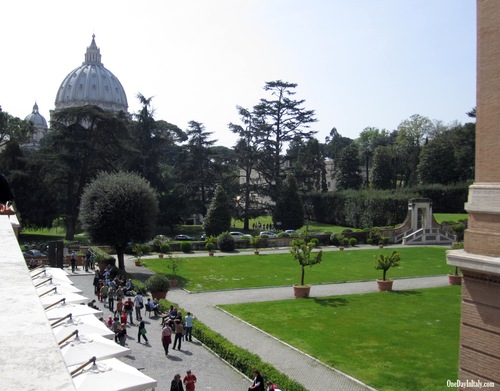
The first problem was finding the entrance. I had assumed that the entrance would be off of St. Peter’s Square, and the tickets I had printed in the US didn’t say any differently, so I spent a while searching till I found a vendor who spoke enough English to tell me where I was going. After walking along the Vatican wall for what seemed like way too long (at least 10 minutes, possibly longer), I saw a ginormous line, the kind I had expected (but hadn’t found) at St. Peter’s that morning.
But I didn’t freak out. I had done my research. I knew that, as there is for most Museums in Italy, there’s a separate line for those who have pre-booked tours. I walked past the endless queue of frustrated, bored and tired-at-11-am tourists, showed the attendant at the entrance my tour reservation and entered the lobby.
I had had this romantic vision that everything having to do with the Vatican would be enchantingly grandiose and rich with history, so when I walked into the pristine entrance hall, gleaming white with contemporary tiled floors and bare walls, I was a bit disappointed. I could’ve been at the Getty Center or the Metropolitan Museum of Art. I had no idea that the entire three-story entrance had been redesigned for Juibilee in 2000. I know, I know, the Vatican Museums are world-class museums and there’s no reason why the entranceway should be “themed”, as if they were an attraction at Disney World. But this is the first reality check that started to break the magic.
You check in for the tour near the sprawling gift shop, to the left of the main lobby. They handed me a name tag and a headphone receiver tuned to channel 2. I stayed relatively close to the tour kiosk so when our tour guide, a short, plump, rather bookish-looking woman in her early 40′s, walked up to the attendent and asked how many were in the group I clearly heard the attended reply “44″ and the tour guide GROAN.
Not a good sign.
But I was still holding on to my excitement. After all, this was the VATICAN! And someone was going to tell me the stories behind it, the anecdotes and little-known-facts! It would be as wonderfully enlightening and enriching as the Colosseum Underground Tour!
Marina raised her voice and introduced herself as our guide, asked us to make sure our headsets were turned on and tuned into channel 2, then advised us to stay close and quickly turned heel and walked out of the gift shop and up the first set of white marble stairs into museums. Like a herd of sheep with a dog nipping at our hindquarters, we pushed against each other to fit up the staircase as we scurried to follow.
Now let’s think about this logically. Forty-four people standing in front of any piece of artwork is going to be too many for everyone to really SEE clearly, and that wasn’t taking into consideration that the museums were open and crowded even before our tour group entered. I felt it right away, as we entered an open courtyard full of ancient antiquities, but in the open space artwork was fairly spread out so I managed to get a good glimpse at the two statues Marina told us about over our wind-staticky receivers.
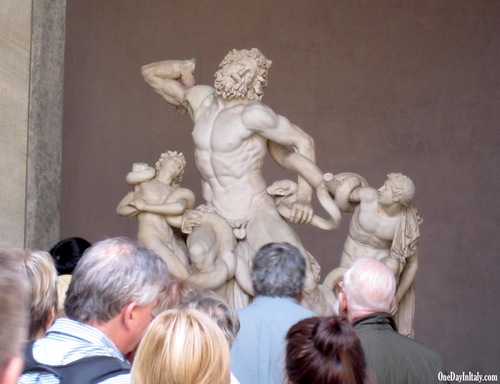
This was a Roman copy of a Greek statue, which I thought was an interesting example of cultural exchange. This COPY was created in 30AD. I was still getting used to things being that old and not looking like ruins. Marina quickly moved on but I managed to snap a couple more pictures before having to rush after the rest of the herd.
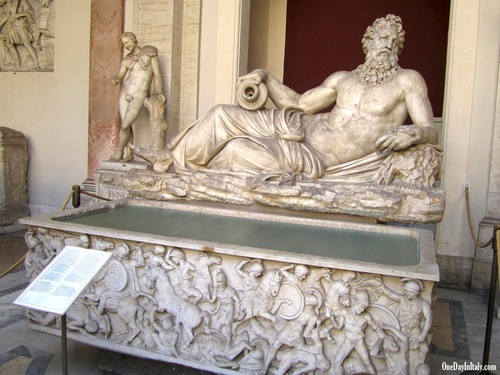
In a separate courtyard Marina stopped in front of a large, green pinecone. This pinecone, Marina explained, was a fountain in the “original” St. Peter’s Basilica.
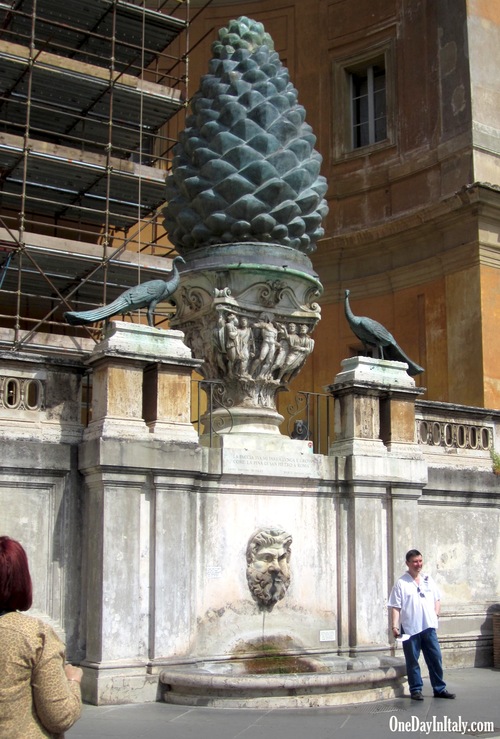
Excuse me?? “Original” Basilica?? A little more of the shine was rubbing off.
Turns out Constantine had built a basilica in the early 4th century but during the Avignon Papacy, when the Pope based himself out of France instead of Rome, the Basilica fell into disrepair. In 1505 Pope Julius II ordered the destruction Constantine’s structure and an entirely new St. Peter’s built. It took almost two hundred years for the artistic masterpiece we know as “Basilica Papale di San Pietro” to be realized.
After adding an aside that peacocks are a symbol of eternal life, she continued her brisk pace into a gallery where, even before I was able to enter the building she began talking about the various schools of Italian art. I was too distracted by trying to get through the door to take in much, and by the time I did she was on her way into the next room! I snapped a quick picture of the painting I thought she was talking about when she mentioned the Tuscan School, and hurried after her.
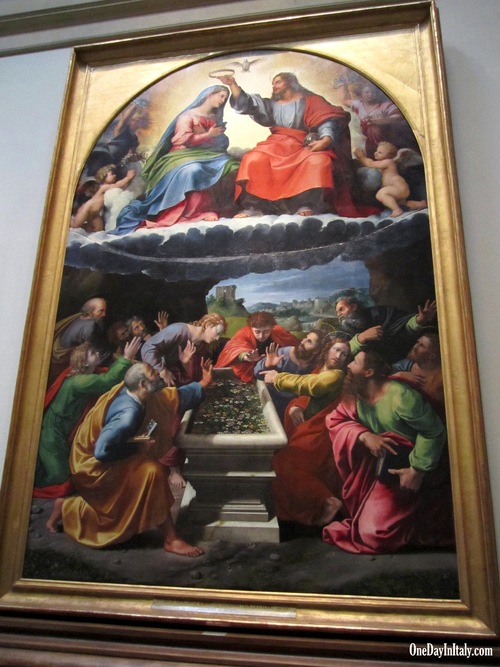
I rushed through the next door and collided with the backpack in front of me. I hate people who stop in doorways!!
Then I peaked over his shoulder, trying to see what Marina was describing – something about statues, the headset had muffled with distance – and saw WHY he had stopped in the doorway.
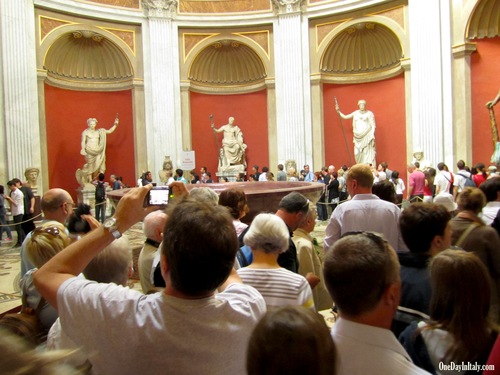
Ahead was a large circular room, the “Sala Rotunda”, salmon-colored insets in the outer wall each framed a tall, majestic statue separated by strong white columns. The ceiling created a gold canopy hovering above some sort of large marble pool, or perhaps it was a fountain. Honestly, I didn’t really register any of it because circled all around, corralled by stations leading around the perimeter and into the next room, was an absolute SOLID MASS of people. The guy in front of me wasn’t moving because he COULDN’T move. People were standing in the walkway taking pictures but it was hard to be mad at them when the other alternative was just standing in the walkway. I felt like I was five years old again and playing “Red Light, Green Light” and the rule was “Take the smallest possible steps you can; shuffle!”. I wanted to scream.
And then I saw it, above the threshold I was stuck under: the perfect representation of my feelings at that moment…
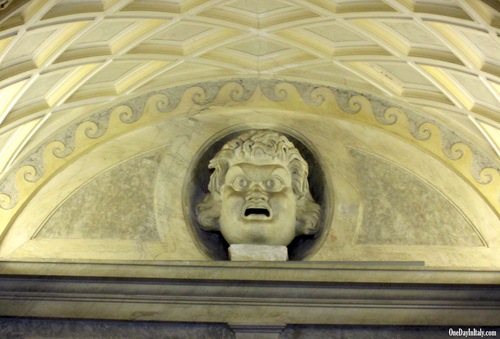
…and I knew it was a sign that God understood. And agreed. (haha)
Once we made it around the circle (Marina’s upraised hand barely visible in the distance weaving through the crowd of museum guests and me too frustrated to really hear anything she said anyway), I have to admit that I, too, was so stunned by the incredible room in front of me that I (almost!) stopped, as well.
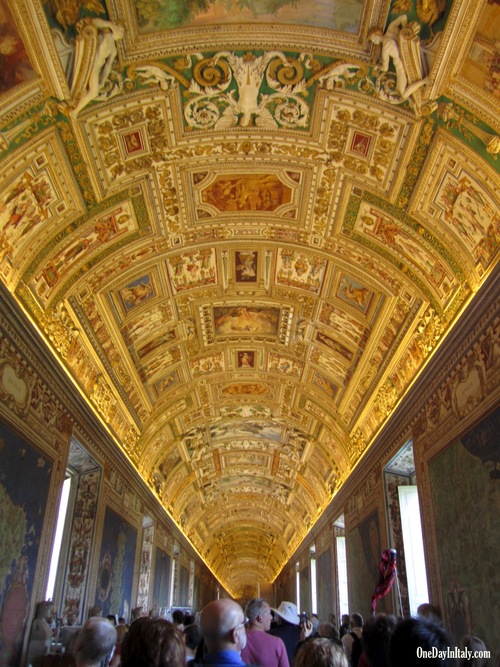
We walked through the Gallery of Maps at a steady pace, but I could’ve stayed in here and looked at the historical maps of Italy, as it was in the late 16th century (not even a nation yet!), painted on the walls for much, much longer. Not to mention the incredible, luminous, intricate ceiling. It would be hard not to be luminous with all that gold, but the upward lighting helped, too ![]() Uber-impactful; beautiful.
Uber-impactful; beautiful.
FINALLY we walked into a room where Marina stopped and waited for everyone to gather. She drew our attention to a figure of Mary and told us this room had been dedicated by Pope Pius IX after the Church proclaimed, in 1854, the dogma of the Immaculate Conception.
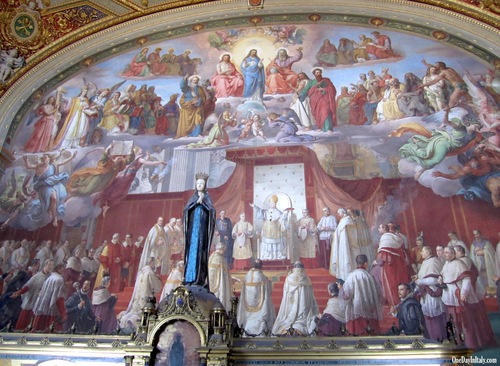
I’ve always been attracted to stories of women in history, and I wondered why – almost 1900 years after her life – the Church felt the need to make a proclamation that Mary was born without original sin. I still don’t quite understand it. I’ve read that there was a lot of controversy about whether or not it was important that Mary be born without sin, whether or not there is Biblical evidence to support it, but that by the 17th century most all theologians accepted the dogma. So why, in 1854, did they need to proclaim it?
That’s really a question – I have no idea.
And Marina certainly didn’t give us time to ask questions. She scurried into the next room, weaving and bobbling through clumps of stagnant tourists.
The next room’s theme was based on Constantine’s belief that perfection was possible in this life through four elements: music and the arts, justice, religion and philosophy.
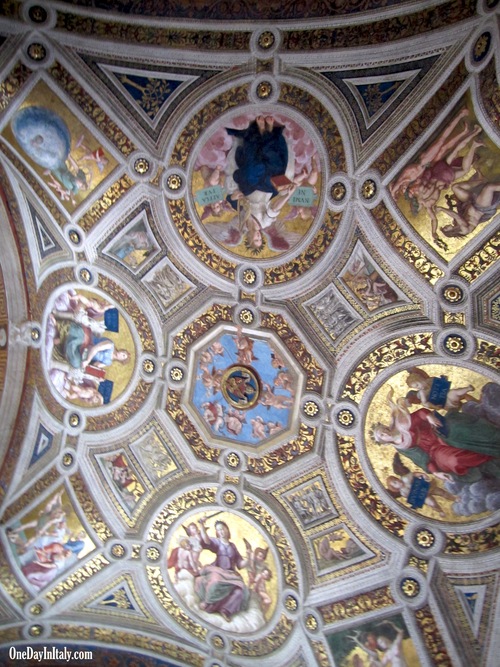
Each of the four walls was painted with a mural representing one of these characteristics, and a herald of sorts for each was painted on the ceiling (music & arts on top of this photo, justice on the bottom, religion on the right and philosophy on the left). Only having time to snap one quick picture before pushing through the next doorway, I took one of the ceiling so I could try to remember the story of Constantine’s four factors of perfection (oooo – I like that alliteration!).
The last room we went into before heading toward the Sistine Chapel might be my favorite – or at least be a part of my favorite anecdote – in the Vatican Museums. Rafael and Michelangelo were both working on various artistic elements of the Vatican at the same time and would often argue about which type of art was the “best”, most compelling and dynamic: painting or sculture. Rafael favored painting, and to illustrate its superiority he painted a mural around a window in this room of the Vatican Museums.
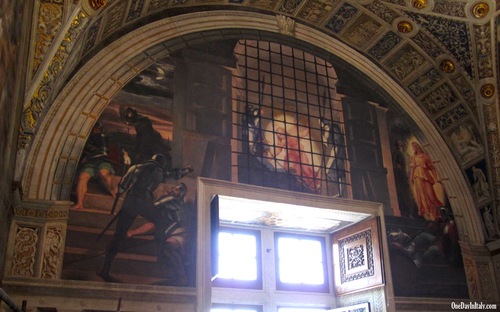
Only painting, he said, could capture the three types of light. To the right he painted a scene with natural light; in the center, supernatural light; and on the right, artificial light.
Everyone was excited to go into the Sistine Chapel. I mean, it’s the Sistine Chapel! A name you hear about from childhood, by one of the world’s most renowned artists, whose scenes are copied in numerous books, movies, paintings, tv shows, greeting cards – if you’ve never seen God’s pointer finger reaching out to man, then you’ve been living under a rock.
We entered and were asked to keep the noise level down inside the chapel. Marina warned us very strongly that no picture taking is allowed, yet all around me flashes were going off and shutters were snapping open and shut, open and shut. And it was CROWDED. I felt a bit like a sardine, but with a much prettier box around me. Unfortunately it was difficult to appreciate the box, because to move around meant looking down and shoulder through a crowd that was packed tightly in a relatively small space, and looking up meant being jostled by others trying to do the same.
I quickly began looking forward to our 20 minutes in the Sistine Chapel being over, ending the tour in the Basilica, and coming back to the Museums to really get a chance to appreciate things that we had just glossed over or ran past.
Then I overheard Marina’s conversation with a nearby couple:
“No, signora, once you enter the Basilica you cannot come back into the Museums. They are two separate entities.”
Wait, WHAT?!
I walked over and joined the conversation.
“If you leave the Museums,” Marina repeated, “you cannot reenter. However, if you wish to stay in the Museums, you do not have to continue the tour.”
I was flabbergasted. I had just paid double museum admission for a tour that rushed us through so quickly I didn’t even really get to step back and *appreciate* the museum, and now they weren’t going to let me back in if I chose to complete the tour I had paid for? That just didn’t – and still doesn’t! – seem right!
So what to do? There had been some things I had peaked through a doorway here or there that I was really looking forward to investigating, and though I hadn’t looked around I *had* been in the Basilica not too long ago. The lines weren’t bad today; maybe I’d go back on my own when I left the museums.
So I left. I walked back through the museum, but the situation was grating on my nerves. The halls were still crowded, though at least I wasn’t having to pray for a glimpse of Marina’s upraised hand and jet after it. Then, the kicker, that I hadn’t had a chance to notice when sprinting through earlier: there’s no information posted in English next to the paintings. For me, art is all about story, and without the story I really don’t care. I want to know who made it, why, for whom – anything that helps me understand the artist and the culture from which they’re inspired. But now I had nothing; nada. And now I wished I had gone into the Basilica!
I exited the Museums, fuming, and walked back to St. Peter’s Square. My fortune continued – or, should I say, misfortune. The line into St. Peter’s Basilica was the exact line I had feared that morning, long, dense and growing bigger every moment. I was definitely *not* in the mood.
I decided to go find lunch somewhere and call my Vatican day over. I had no idea what else I was going to do; I had planned on spending a lot of the afternoon exploring the history the Museum would showcase. I decided to start with a pizza in the Prati. Pizza is always a good place to start (just like gelato is always a good place to end).
Speaking of gelato, I looked for a famous gelato shop, Old Bridge, on my way out and couldn’t find it. Just *another* thing that was souring my mood that day!
That day, the lows greatly seemed to outweigh the highs. I was in a bad mood for pretty much the entire day and most of the next morning. More just kept happening to reinforce my foul temperament. But more on those things in another post; for now, I’ll just leave you with a firm recommendation NOT to take a tour of the Vatican Museums.
If you do, don’t say I didn’t warn you.
Comments
comments












Leave a Reply